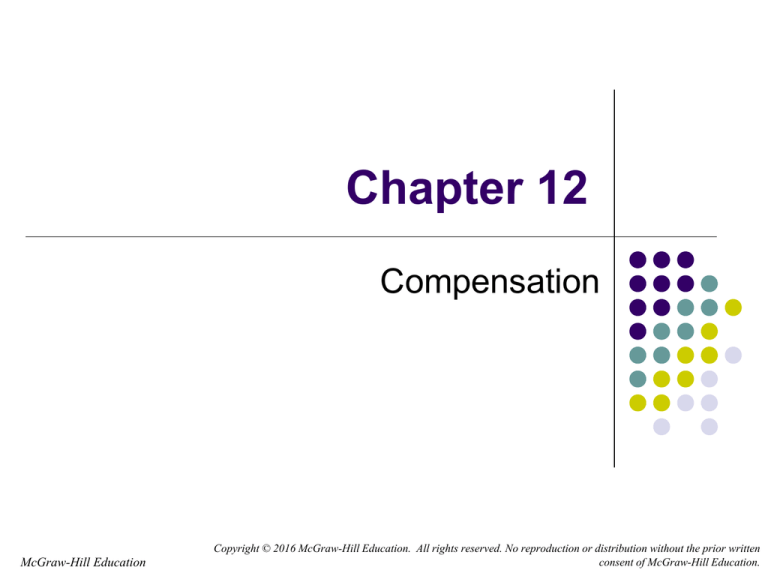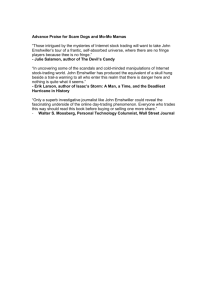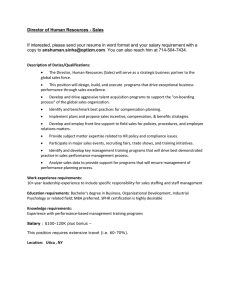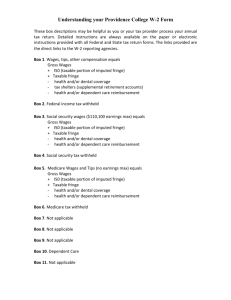
Chapter 12
Compensation
McGraw-Hill Education
Copyright © 2016 McGraw-Hill Education. All rights reserved. No reproduction or distribution without the prior written
consent of McGraw-Hill Education.
Learning Objectives
1.
2.
3.
Discuss and explain the tax implications of
compensation in the form of salary and wages
from the employee’s and employer’s perspectives
Describe and distinguish the tax implications of
various forms of equity-based compensation from
the employer’s and employee’s perspectives
Compare and contrast taxable and nontaxable
fringe benefits and explain the employee and
employer tax consequences associated with fringe
benefits
12-2
Salary and Wages
Employee Considerations for Salary and
Wages
Fixed amount of compensation for the current
year no matter how many hours worked
Salaried employees eligible for bonuses
Employees receiving wages generally get paid
by the hour
Salary, bonus, and wages taxed as ordinary
income
They report their wages on page 1, line 7 of the
1040 federal tax return
12-3
Salary and Wages
Withholding Taxes
Employees complete a Form W-4 to supply the
information the firm needs to withhold the correct
amount of tax and also to indicate
Whether to withhold at the single rate or at the lower
married rate
The number of withholding or “personal” allowances
the employee chooses to claim
Whether the employee wants an additional amount
of tax withheld each period above the amount based
on the number of allowances claimed
12-4
Salary and Wages
Form W-2
Summarizes an employee’s taxable salary and
wages
Provides annual federal and state withholding
information
Generated by employer on an annual basis
Form W-4
Supplies an employee’s withholding information to
employer
Generated by employee
Remains constant unless employee makes
changes
12-5
Salary and Wages
Employer Considerations for Salary and
Wages
Deductibility of Salary Payments – General Rule
Employers computing taxable income under
Cash method of accounting generally deduct salary and
wages when they pay the employee
Accrual method generally deduct wages payable to
employees as the employees earn the wages
Compensation expense accrued at end of year is
deductible in year accrued if
paid to an unrelated party
paid within 2½ months of year-end
12-6
Salary and Wages
Compensation expense accrued at end of year is
deductible when
paid to related party
related party (employee) owns > 50 percent of the value of
the employer corporation
After-tax cost of providing this salary is generally much
less than the before-tax cost as the employer deducts
the salary and associated FICA taxes paid
After-Tax Cost of Salary formula
12-7
After-Tax Cost of Salary Question
XYZ, Inc. paid one of its employees $80,000.
They are in the 35% tax bracket. What is the
after-tax cost of the salary to XYZ, Inc.?
12-8
After-tax Cost of Salary
Solution
Before-tax cost = Salary
Total cost = $80,000
After-tax cost = $80,000 * (1 – 35%)
So the after-tax cost = $52,000
12-9
Salary and Wages
Limits on salary deductibility
Determining whether compensation is reasonable in
amount is a “facts and circumstances test” involves
considering the duties of the employee
complexities of the business, and
amount of salary compared with the income of the
business among other things
$1,000,000 maximum annual compensation deduction
per person
Limited—applies to CEO and three other highest
compensated officers, not including CFO
Does not apply to performance-based compensation
12-10
Equity-Based Compensation
Stock Options
Incentive stock options - provide favorable tax
treatment to employees
Nonqualified stock options - options that don’t
meet the requirements for being classified as
incentive stock options
Grant date - Date on which employees are
initially allocated stock options
Exercise date - Date that employees purchase
stock using their options
Exercise price - Amount paid to acquire shares
with stock options
12-11
Equity-Based Compensation
Bargain element - Difference between the fair
market value of stock and the exercise price on
the exercise date
Vesting date - Time when stock options granted
can be exercised
Employee Considerations for Stock Options
Nonqualified stock options
When exercising NQOs, employees report ordinary income
equal to the total bargain element on the shares of stock
acquired (whether they hold the shares or sell them
immediately)
12-12
Equity-Based Compensation
Incentive stock options
Taxpayer’s basis in NQOs acquired is the fair market
value on the date of exercise
Basis includes the exercise price plus the ordinary
income the taxpayer recognizes on the bargain element
Basis in shares acquired with ISOs is the exercise price
Holding period for stock acquired with NQOs and ISOs
begins on the exercise date
Here bargain element is added to taxpayers alternative
minimum taxable income
For either type of options, employees experience no
tax consequences on the grant date or vesting date
12-13
Equity-Based Compensation
Any future appreciation or depreciation of the stock
will be treated as either short-term or long-term
capital gain or loss depending on the holding period
(begins on the date of exercise)
Employer Considerations for Stock Options
Nonqualified options
No tax consequences on grant date
On exercise date, bargain element is treated as ordinary
(compensation) income to employee
Employee holds stock with holding period beginning on
date of exercise
Employers deduct bargain element as compensation
expense on exercise date
12-14
Equity-Based Compensation
Incentive stock options
No tax consequences on grant date and exercise date (if
employee holds for two years after grant date and one year after
exercise date)
If holding requirements are not met (if there is a disqualifying
disposition), option becomes an NQO
When employee sells stock, employee recognizes long-term
capital gain
No deduction for employers unless employee doesn’t meet
holding requirements
Employers typically don’t view ISOs as favorable as NQOs,
because:
ISOs don’t provide them with the same tax benefits (no tax
deduction)
IRS regulatory requirements for ISOs can be cumbersome
12-15
Equity-Based Compensation
Firms with high marginal tax rates may lose significant tax
benefits by issuing ISOs rather than NQOs
On the other hand, start-up companies or firms with net
operating losses may actually benefit by issuing ISOs
instead of NQOs
Accounting Issues
For tax purposes, employer deducts bargain element on
exercise date
For GAAP purposes, employer expenses the estimated
value of the option pro rata over the vesting period
12-16
Equity-Based Compensation
12-17
Stock Options Questions
Mary is offered 7,000 options on Jan. 1st, 2012.
They vest on Jan. 1st 2015. The exercise price is
$10 per share. On Jan. 1st 2015 she exercises all
7,000 options when the price is $17 per share. She
holds the stock for two years and sells all 7,000
shares for $20 per share. She is in the 30% tax
bracket. What is her tax liability on the grant date,
exercise date, and date of sale?
If the options are ISO’s?
If the options are NQO’s?
12-18
Stock Options Solution
If the options are ISO’s:
Grant date: No tax liability
Exercise Date: No tax liability
Sale Date: Because she held the stock for 1
year after exercise date she will be taxed on the
full appreciation from the exercise price at
preferential rates. $10 per share appreciation
times 7,000 shares = 70,000 gain
Tax liability = 70,000 * .15 = $10,500 tax
12-19
Stock Options Solution
If options are NQOs:
Grant date: No tax liability
Exercise date: $7 bargain purchase * 7,000
shares = $49,000 * 30% = $14,700
Sale date: $3 appreciation * 7,000 shares =
$21,000 * 15% = $3,150
12-20
Equity-Based Compensation
Restricted Stock
Can’t be sold or otherwise treated as owned
by employees until employees legally have
the right to sell the shares on the vesting date
Employees receive restricted stock on the
vesting date without having to pay for it, after
which they can either sell it immediately or
retain it
Employee Considerations for Restricted Stock
Restricted Stock are taxed on the full fair market
value of the shares on the date the restricted
stock vests
12-21
Equity-Based Compensation
Without §83(b) Election
No tax consequences on grant date
Employee recognizes ordinary income on value of stock on
vesting date
Holding period for stock begins on vesting date
Employer deducts value of stock on vesting date
With Section §83(b) Election
On grant date, employee recognizes market value of stock
as ordinary income
Employee takes fair market value basis in stock
Holding period for stock begins on grant date
If employee never vests, no deduction for basis in stock
Employer deducts value of stock on grant date
12-22
Equity-Based Compensation
Employer Considerations for Restricted Stock
Timing of the deduction is determined by the employee’s
decisions regarding the §83(b) election
Other non tax issues
For tax purposes, employers deduct the market value of
stock when the employee recognizes income
For GAAP purposes, employers deduct the grant date value
over the vesting period
12-23
Restricted Stock Question
James received 4,000 shares of restricted stock on
June 1st, 2014 when the stock was valued at $3 per
share. The shares vest on June 1st 2015 when the
shares are valued at $8 per share. He sells the
shares on the vesting date. He is in the 30% tax
bracket. What is his tax liability on the grant date
and vesting date?
If he doesn’t make an 83(b) election?
If he makes an 83(b) election?
12-24
Restricted Stock Solution
If 83(b) election not made:
Grant date: no tax liability
Vesting date: $8 per share * 4,000 shares = $32,000 * .3 =
$9,600 tax liability.
If 83(b) election is made:
Grant date: $3 per share * 4,000 shares = $12,000 * .3 =
$3,600 tax liability
Vesting date/sales date: $5 appreciation * 4,000 shares =
$20,000 * .15 = $3,000 tax liability
12-25
Equity-Based Compensation
12-26
Fringe Benefits
Employers often provide noncash benefits to
employees in addition to their cash compensation
Ranges from common (health insurance) to the
exotic (use of a corporate aircraft)
Taxable to the employee on receipt
IRC §61(a) indicates that, “gross income means all
income from whatever source derived, including
Compensation for services, including fees,
commissions, fringe benefits, and similar items
(emphasis added)”
12-27
Fringe Benefits
Taxable Fringe Benefits
Employees recognize compensation income on all benefits
received unless specifically excluded by tax laws
Treats benefits received like taxable cash compensation
Employer deducts cost and pays employee’s share of FICA
taxes on benefit
Employee Considerations for Taxable Fringe Benefits
Employees may prefer a taxable benefit to an equivalent
amount of cash when they benefit from employer-provided
quantity or group discounts associated with the benefit
12-28
Fringe Benefits
Employees must recognize a certain amount of gross
income when employers pay life insurance premiums for
the employee for policies with a death benefit in excess of
$50,000
To compute the annual taxable benefit, taxpayers use the
following steps
Step 1: Subtract $50,000 from the death benefit of their
employer-provided group-term life insurance policy
Step 2: Divide the Step 1 result by $1,000
Step 3: Multiply the result from Step 2 by the cost per
$1,000 of protection for one month from the table provided
in the Treasury Regulations based on the taxpayer’s age
Step 4: Multiply the outcome of Step 3 by 12 (months)
12-29
Fringe Benefits
12-30
Fringe Benefits
Employer Considerations for Taxable Fringe
Benefits
Treat taxable fringe benefits just like cash
compensations
Has an outlay for the cost of the benefit and must pay
the employer’s share of FICA taxes on the taxable
portion of benefits it provides to employees
Deducts its cost of the benefit (plus FICA taxes), not the
value of the benefit to the employee
Are often able to purchase fringe benefits at a lower cost
than can individual employees
12-31
Fringe Benefits
12-32
Fringe Benefits
Nontaxable Fringe Benefits
Specifically identified in the Code
Employee excludes benefit from taxable income
Employer deducts cost when benefit is paid
Group-Term Life Insurance
Health and Accident Insurance and Benefits
Meals and Lodging for the Convenience of the
Employer
Employee Educational Assistance
Dependent Care Benefits
12-33
Fringe Benefits
No-Additional-Cost Services
Qualified Employee Discounts
Working Condition Fringe Benefits
De Minimis Fringe Benefits
Qualified Transportation Fringe
Qualified Moving Expense Reimbursement
Cafeteria Plans and Flexible Spending Accounts
(FSAs)
Employee and Employer Considerations for
Nontaxable Fringe Benefits
12-34
Fringe Benefits
12-35
Fringe Benefits
12-36
Fringe Benefits
Tax Planning with Fringe Benefits
Example
Employer proposed to reimburse employee $200 a month
for his parking costs. What amount of this reimbursement
would be a nontaxable qualified transportation fringe to
employee?
Answer: All $2,400. Employee can exclude up to $250 per
month ($3,000 per year) as a qualified transportation fringe
IRS publication 15-B “Employer’s Tax Guide to Fringe
Benefits” (available at www.IRS.gov) provides tax
guidance for employers providing fringe benefits
12-37
Fringe Benefits
Fringe Benefits Summary
Both taxable and nontaxable, can make up a
significant portion of an employee’s compensation
Are taxable unless the tax laws specifically exclude
them from gross income
Taxable fringe benefits usually represent a luxury
perk, while nontaxable fringe benefits are generally
excluded for public policy reasons
At this point, you should be able to distinguish
between taxable and nontaxable fringe benefits
12-38
Fringe Benefits
12-39







